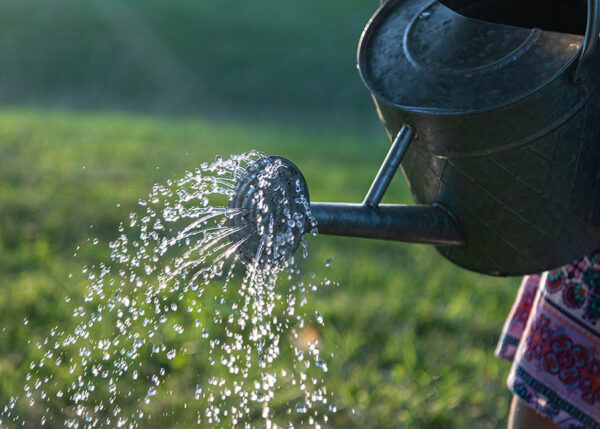Proper watering is one of the most crucial elements to successful gardening, and a simple soil drainage test can help you understand how to give your trees, shrubs, veggie plots and garden beds the hydration they need for good health.
Supplies:
- shovel
- stick (2-3 foot tall)
- tape measure, ruler or yardstick
- marker
- water
Choose the location to test. If you are planting a tree or shrub you can measure drainage in the hole you plan to plant into. For veggie plots and garden beds, consider testing more than one hole since conditions can be very different from one end of a garden to another. New construction can have drastically different soil types within a few feet because excavation churns up clay soil which is then used to push around new foundations instead of rich topsoil. Slopes, walls, and sidewalks can also affect drainage.
Use your shovel to dig a hole in the soil at least one foot deep and one foot wide. Clear loose dirt from the hole so that it has clean walls.
Use a watering can, pickle bucket, or hose to fill the hole with water. Let the water fully drain. Saturating the soil before testing will produce a more accurate result and indicate the best time interval for marking your measurements. (If the water drains fairly quickly you’ll want to set your marking time intervals at 5-15 minutes.)
Place a stake or stick into the soil at the bottom of the hole so that it stands up straight and rises above the opening.
Fill the hole with water again until nearly full and mark a line on the stake at the water line.
Set a timer to check the water every 5-15 minutes for fast-draining soil or up to every hour for slow-draining sites. Mark the stake at the water level at each time increment and observe how long it takes the water to completely drain. Then measure the distance between your incremental marks on the stake to calculate how fast your soil is draining in that location.
Calculate how many inches of water per hour drained.
 1-3 inches per hour
1-3 inches per hour
Ideal soil drainage is about 2 inches per hour, although rates between 1 and 3 inches are generally fine for most plants. This soil texture is referred to as loam and most gardeners would give their eye teeth to have it. Loam is ideal for most plants since it holds water for the perfect amount of time for roots to fully hydrate foliage and fruit without cutting off healthy aerobic respiration. A regular watering schedule is ideal for loamy soils.
That said, certain succulent and Mediterranean plants may prefer more sharp drainage. For these plants, you can amend soil directly around plant roots and even raise the soil level of the bed with added sand and rock to give the sharp drainage needed by plants like hardy agaves and cactus, rosemary, lavender, and sage.
Results less than 1 inch per hour
In the VVN region, most soil will yield drainage results of less than 1 inch per hour since our soil is most commonly high in clay. Clay soils are made up of extremely small particles that become tightly compacted, reducing air and water flow. New homes are often surrounded with clay soil from construction excavation. Clay soils will easily become water-logged, so adding organic matter and mulch is essential to increase porosity, break up compaction, and better absorb and drain water.
Make sure you aren’t overwatering plants in clay soils since they hold water and drain slowly. Allow the soil time to dry in between waterings. Always double check soil moisture levels by sticking your finger 2-3 inches into the soil. Clay soils may appear dry on top but can still be moist below the surface. Most native prairie plants are well-adapted to growing in clay soil.
The easiest solution to growing plants in poorly draining soils is to select plants that thrive in those conditions. Click here for plants that tolerate poor drainage.
Results greater than 3 inches per hour
If your soil drains faster than 3 inches per hour it’s very likely high in sand and gravel. This type of soil tends to drain so quickly that it can be hard for plants to fully absorb moisture which makes frequent watering essential. Adding organic matter will increase soil humus which will help trap and hold moisture around plant roots. Water frequently but in shorter time increments to conserve water while you build your soil with organic matter.
Select drought-tolerant plants or those that prefer dry conditions if you’re looking for a lower-maintenance solution.
